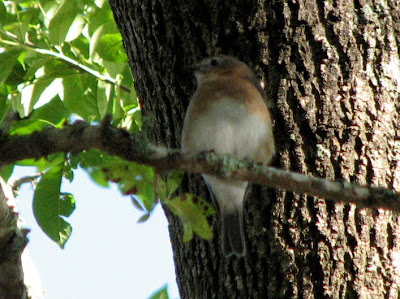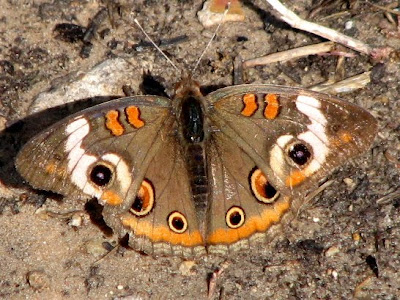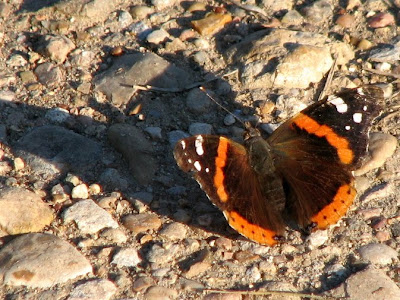.Our yards were just starting to fill up with birds again when we were hit by another major storm. The weather had improved by yesterday afternoon but few birds had returned. Apart from a few House Finches, a Ruby-crowned Kinglet and a skittish White-winged Dove, the only bird that came to our front yard yesterday afternoon was a Yellow-bellied Sapsucker. The same was true this morning.
We currently have at least two Sapsuckers. One of them is an adult male with a very red chin and throat. One of them appears to have much less red and so I'm wondering if it is a younger male.

 I've noticed that the Sapsuckers are very leery of being watched. They will happily forage in our elm tree quite unperturbed while kids play right under the tree and cars drive by just a few yards away. I can even walk around or stand at the base of the tree without disturbing them. However, as soon as I start watching them or trying to take a photo, they fly off to another yard. So I assume that they notice when eyes are directed at them and they take this as a sign of danger.
I've noticed that the Sapsuckers are very leery of being watched. They will happily forage in our elm tree quite unperturbed while kids play right under the tree and cars drive by just a few yards away. I can even walk around or stand at the base of the tree without disturbing them. However, as soon as I start watching them or trying to take a photo, they fly off to another yard. So I assume that they notice when eyes are directed at them and they take this as a sign of danger.
.
I had a free 90 minutes yesterday morning and so I jumped into the car and headed over from the college to Bear Creek Park in hopes of seeing a Vermilion Flycatcher. We're well outside the normal range of this stunning bird, but an adult male has wintered on the Bear Creek golf course for the past six years and was spotted there again the other day.At 9:20 I turned onto Golf Course Road and parked where I could see the area where the flycatcher always hangs out: the trees around the water hazard near the ninth hole.
By 9:30 I was feeling frustrated and antsy. I kept seeing patches of bright red in the trees but I was too far away to tell if I was seeing the flycatcher or a Northern Cardinal or just some brightly colored leaves. It didn't help that the light was poor and that I'd left my good binoculars at home and was using a cheap old pair that I keep in the car.
So I gave up on the flycatcher and drove into the park proper to bird N. Golbow Road.
We've had a lot of rain lately and large areas of the park were flooded. (As the local constable put it when he pulled up beside me for a chat, "You just have to pee in Bear Creek and the whole park floods.")
 Many of the minor roads were closed to vehicles ...
Many of the minor roads were closed to vehicles ...
 picnic tables had become islands ...
picnic tables had become islands ...
 and the restrooms were inaccessible.
and the restrooms were inaccessible. I love it when Bear Creek is like this, because the flooded areas usually draw in large numbers of wading birds.
I love it when Bear Creek is like this, because the flooded areas usually draw in large numbers of wading birds.
As soon as I started walking along Golbow, I saw several Great Egrets, Snowy Egrets and a Great Blue Heron. There were other birds, too. Carolina Chickadees, Tufted Titmice and Pine Warblers. I spotted a Downy Woodpecker, followed by a couple of Red-bellied Woodpeckers and my FOS Northern Flicker. Then I heard the unmistakeable call of a Pileated Woodpecker. The light was bad and the bird was too high up for a decent photo but the red crest was clearly visible.
 A moment later it flew away, to be followed almost immediately by another Pileated.
A moment later it flew away, to be followed almost immediately by another Pileated.
We only get six woodpecker species in Houston and I'd now seen four of them in only 10 minutes. I decided that it would be really neat to see all six species on one day. Perhaps not quite as thrilling as seeing the "Big Five" mammals in South Africa's Kruger Park three years ago, but definitely worth doing.
So I turned back to where I had parked the car at the junction of Golbow and Dorpslauf Road. The area immediately southwest of the junction is the best place I know for woodpeckers and I was pretty confident that I would see a Red-headed Woodpecker there. The sixth bird, Yellow-bellied Sapsucker, might be tougher to locate but I would worry about that in due course.
I should have known. The very first bird I clapped eyes on was a Yellow-bellied Sapsucker. And at almost the same moment, I heard Red-headed Woodpeckers calling. Seeing the "little six" was going to be even easier than seeing the "Big Five" had been in Kruger.
Ten minutes later I was feeling very frustrated! I could hear Red-headeds calling everywhere around me but I couldn't see any of the birds. They were all in areas that I couldn't reach because of the floodwaters. (I was in my work clothes and it wouldn't do to return to the college looking like I'd been playing in the mud.)
Other birds were being a nuisance, too, by trying to distract me. Downy Woodpeckers, Eastern Bluebirds, Tufted Titmice and an Eastern Phoebe kept popping up on nearby branches and begging me to take their photos. The light was still terrible but I took a couple of photos just to get rid of the pesky little birds.

 10:00 a.m. rolled around and still no Red-headed.
10:00 a.m. rolled around and still no Red-headed.
Then, at 10:05, I spotted one. No, two. They were too far away for photos but easy to identify. Here's a picture of one from an earlier visit to the same area.
 All six woodpeckers in exactly 30 minutes. Not bad at all.
All six woodpeckers in exactly 30 minutes. Not bad at all.
Since I was obviously on a roll, I just had to go back to the golf course to look for the Vermilion Flycatcher. Remember him? He's the reason I came over to Bear Park in the first place.
I sat in the car scanning the area near the ninth hole. There was a Great Egret. There were Killdeer. There was a Loggerhead Shrike. A Double-crested Cormorant flew over. A couple of Turkey Vultures circled above. Fifteen minutes ticked by. And there he was! Perched right on top of a tree, the red of his plumage spectacularly bright against the blue sky. No chance of a photo but, in case you're not familiar with the Vermilion Flycatcher, here's one I photographed in Big Bend National Park last year.
 Six woodpeckers and a Vermilion Flycatcher, plus a dozen or more other species in a little over an hour. I love Bear Creek!
Six woodpeckers and a Vermilion Flycatcher, plus a dozen or more other species in a little over an hour. I love Bear Creek!
..
 .
.
. I sat out in our front yard for a few minutes late this afternoon and was pleased to see that one of the Yellow-bellied Sapsuckers was enjoying hunting for insects in the bark of our elm. I was also happy to see that we once again have a group of 7-8 House Finches coming to the feeders.
Just as I was about to go indoors, I noticed some movement high in the branches of the elm. A very small bird was busily hopping around among the leaves. The way it was foraging immediately made me think "Ruby-crowned Kinglet". I grabbed my camera and managed to get just one photo as the bird came out partly into the open before flying away. It was a Ruby-crowned Kinglet.

So that's another of our winter residents that's managed to make it safely back to Texas and our yards. I wonder which will be the next one to show up.
.So why were there so many birders at the Hornsby Bend sewage plant on Sunday? Well, it turned out that they were there to see a very special bird: a Red Phalarope. This is a species which is at home on the Atlantic and Pacific Oceans but rarely visits the US mainland. So to have one arrive in Austin, miles from either ocean and well inland was certainly an unusual event.The bird was first spotted on Saturday, when it cruised near the edge of the pond and let birders photograph it from just feet away. Unfortunately, on Sunday it stayed near the middle of the pond and was clearly visible only through spotting scopes.
This is the closest view I got of it! After waiting vainly for a while to see if the Phalarope would come nearer, I gave up and drove around the other ponds. Most of the ducks, including a pair of Wood Ducks, also stayed well out of reach but some Pied-billed Grebes came fairly close ...
After waiting vainly for a while to see if the Phalarope would come nearer, I gave up and drove around the other ponds. Most of the ducks, including a pair of Wood Ducks, also stayed well out of reach but some Pied-billed Grebes came fairly close ...
 while American Coots were less standoffish than earlier in the morning.
while American Coots were less standoffish than earlier in the morning. A Spotted Sandpiper, too, was more cooperative.
A Spotted Sandpiper, too, was more cooperative. The edges of the ponds were vey busy with Hackberry Emperor (?) butterflies. The hardest part of photographing these was that they tended to land on and crawl around the top of my camera.
The edges of the ponds were vey busy with Hackberry Emperor (?) butterflies. The hardest part of photographing these was that they tended to land on and crawl around the top of my camera.
 Mid-morning I left Hornsby Bend so that Dee and I could check out of the motel, get lunch and visit one more site before driving home.The site we chose was McKinney Falls State Park, only a few miles outside Austin itself.
Mid-morning I left Hornsby Bend so that Dee and I could check out of the motel, get lunch and visit one more site before driving home.The site we chose was McKinney Falls State Park, only a few miles outside Austin itself.

 On an earlier visit, two summers ago, we saw plenty of birds there. This time, our total in an hour was 3 birds. (That's three total individuals, not species!)
On an earlier visit, two summers ago, we saw plenty of birds there. This time, our total in an hour was 3 birds. (That's three total individuals, not species!)
An Eastern Phoebe greeted us.
 After that, all we saw was a pair of Red-tailed Hawks.
After that, all we saw was a pair of Red-tailed Hawks.
 Of course, the fact that the hawks kept circling overhead was probably why we didn't see any other songbirds.
Of course, the fact that the hawks kept circling overhead was probably why we didn't see any other songbirds.
However, it was still worth the hour we spent there. It's a beautiful park, there were lots of butterflies, and there were also some interesting plants.


 .
.
.At dawn on Sunday I was driving around Austin's sewage plant - or, as they call it here, "the Hornsby Bend water treatment facility."
The first of the large ponds had several Pied-billed Grebes. The light was still very poor but I managed to get one viewable photo. The Grebes were sharing the pond with rafts of American Coots.
The Grebes were sharing the pond with rafts of American Coots.
 The Coots were unconcerned as long as I stayed in the car but, as soon as I got out, they would panic and take to flight.
The Coots were unconcerned as long as I stayed in the car but, as soon as I got out, they would panic and take to flight.
 A walk down to the river produced nothing except Northern Cardinals and Carolina Chickadees but the ponds started to show more signs of life as the sun rose.
A walk down to the river produced nothing except Northern Cardinals and Carolina Chickadees but the ponds started to show more signs of life as the sun rose.
While White-faced Ibis wheeled overhead, Cattle Egrets began to waken up on the tree where they had been roosting.

 As the light improved, Eastern Phoebes and Scissor-tailed Flycatchers started hunting for their breakfasts.
As the light improved, Eastern Phoebes and Scissor-tailed Flycatchers started hunting for their breakfasts.
 Blue-winged Teal and Northern Shovelers were cruising the pond ...
Blue-winged Teal and Northern Shovelers were cruising the pond ...
 sieving the water for their food.
sieving the water for their food.
 Several Ruddy Ducks were the first I had seen in Texas this year.
Several Ruddy Ducks were the first I had seen in Texas this year.

The second pond more American Coots, as well as a few American Avocets, four Great Egrets, a Marsh Wren and my first fall Lincoln's and Savannah Sparrows. However, the air here was too thick with fumes for me to linger very long.
 By now, I'd noticed that several other cars of birders had arrived. I wondered if perhaps a local birding club had organized a trip to the site. As I soon learned, the truth was much more exciting. But I'll wait until tomorrow to post about what was really going on.
By now, I'd noticed that several other cars of birders had arrived. I wondered if perhaps a local birding club had organized a trip to the site. As I soon learned, the truth was much more exciting. But I'll wait until tomorrow to post about what was really going on.
We couldn't have chosen a better weekend for our visit to Austin. The weather was absolutely perfect - sun blue skies and 75 degrees.
We broke the 2.5 hour drive with a picnic lunch at Bastrop State Park. The air was beautifully clear and it was great to be in hilly country country again.
 Although we only stayed an hour, and it was early afternoon, there were plenty of birds around. Turkey and Black Vultures flew over, while the trees were busy with Red-bellied and Downy Woodpeckers, Carolina Chickadees, Blue-gray Gnatcatchers, and Pine Warblers. Unfortunately, none of them would oblige me by posing for photos.
Although we only stayed an hour, and it was early afternoon, there were plenty of birds around. Turkey and Black Vultures flew over, while the trees were busy with Red-bellied and Downy Woodpeckers, Carolina Chickadees, Blue-gray Gnatcatchers, and Pine Warblers. Unfortunately, none of them would oblige me by posing for photos.
We checked into our motel in Austin and then went over to the Zilker Botanical Gardens. Unlike the botanical gardens in Phoenix and Salt Lake City, Zilker is not wonderful for birds. In fact, the only birds we saw there were Great-tailed Grackles.
 However, they are great for butterflies ...
However, they are great for butterflies ...


 and other bugs.
and other bugs.
 And if you're not into bugs, you can always admire the plants.
And if you're not into bugs, you can always admire the plants.



 That night I turned in early, to be ready for an early morning drive to the Hornsby Bend sewage plant on Sunday. Dee had decided that she didn't want to get up before dawn on Sunday. As you'll see tomorrow, this was a mistake.
That night I turned in early, to be ready for an early morning drive to the Hornsby Bend sewage plant on Sunday. Dee had decided that she didn't want to get up before dawn on Sunday. As you'll see tomorrow, this was a mistake.























































